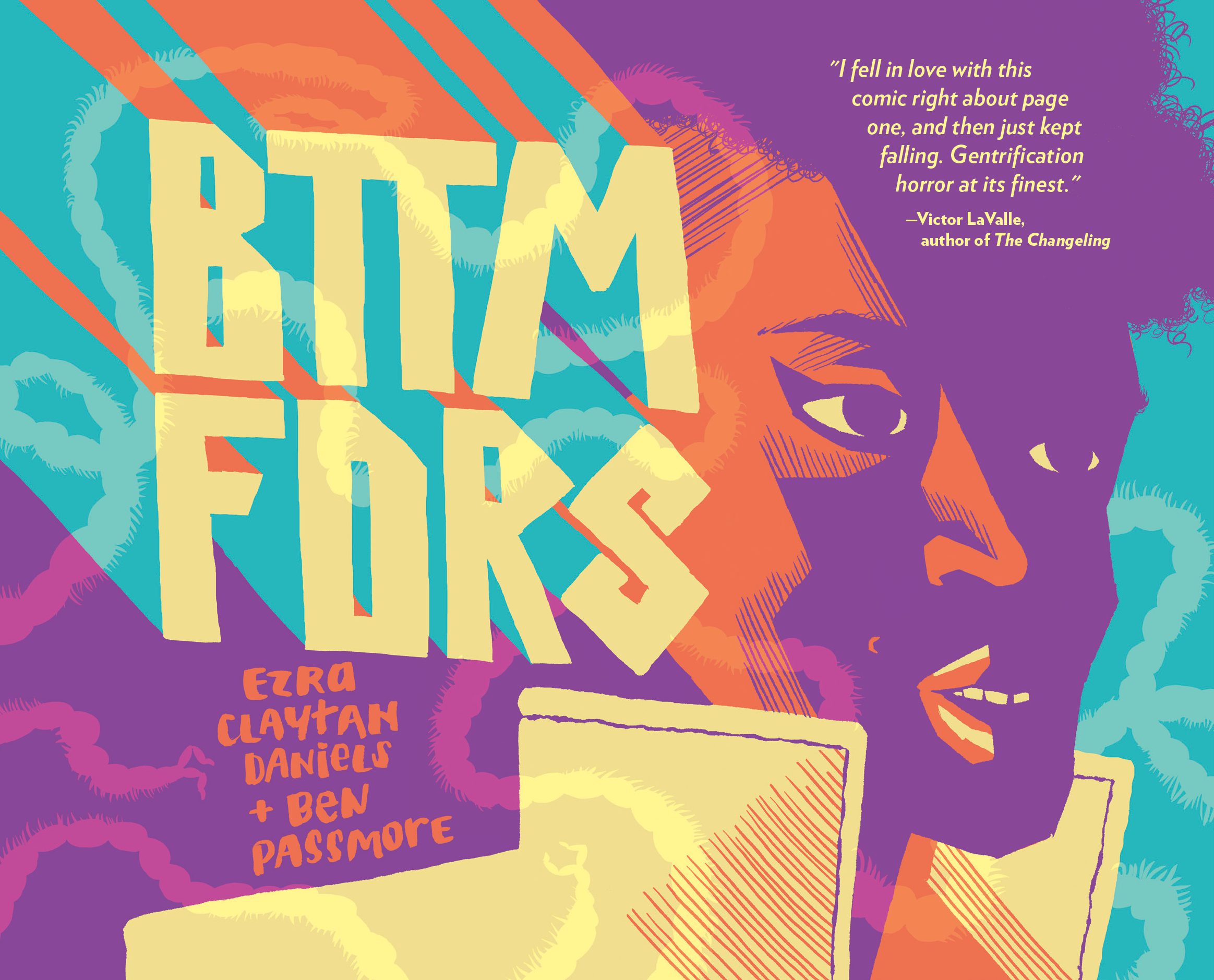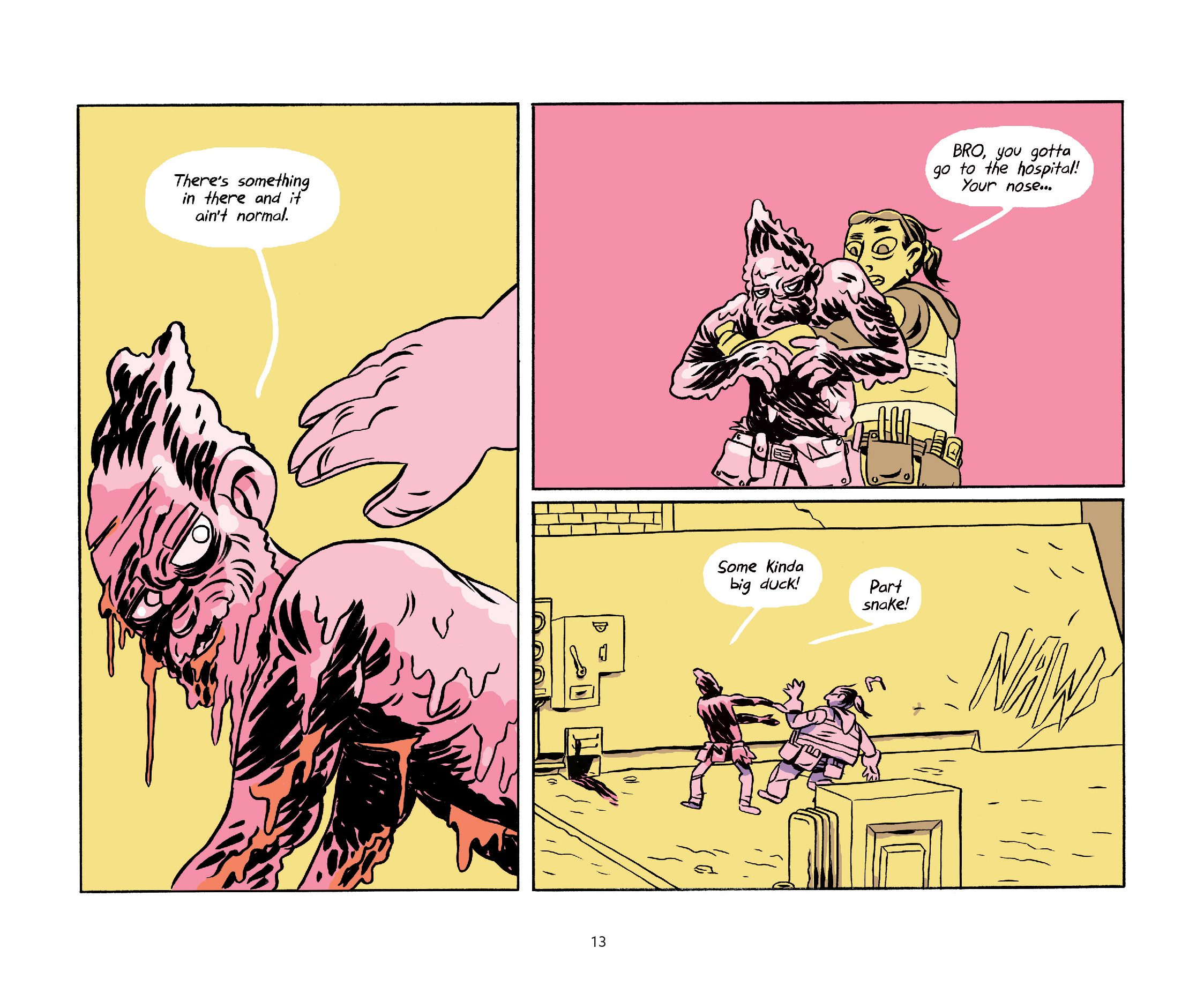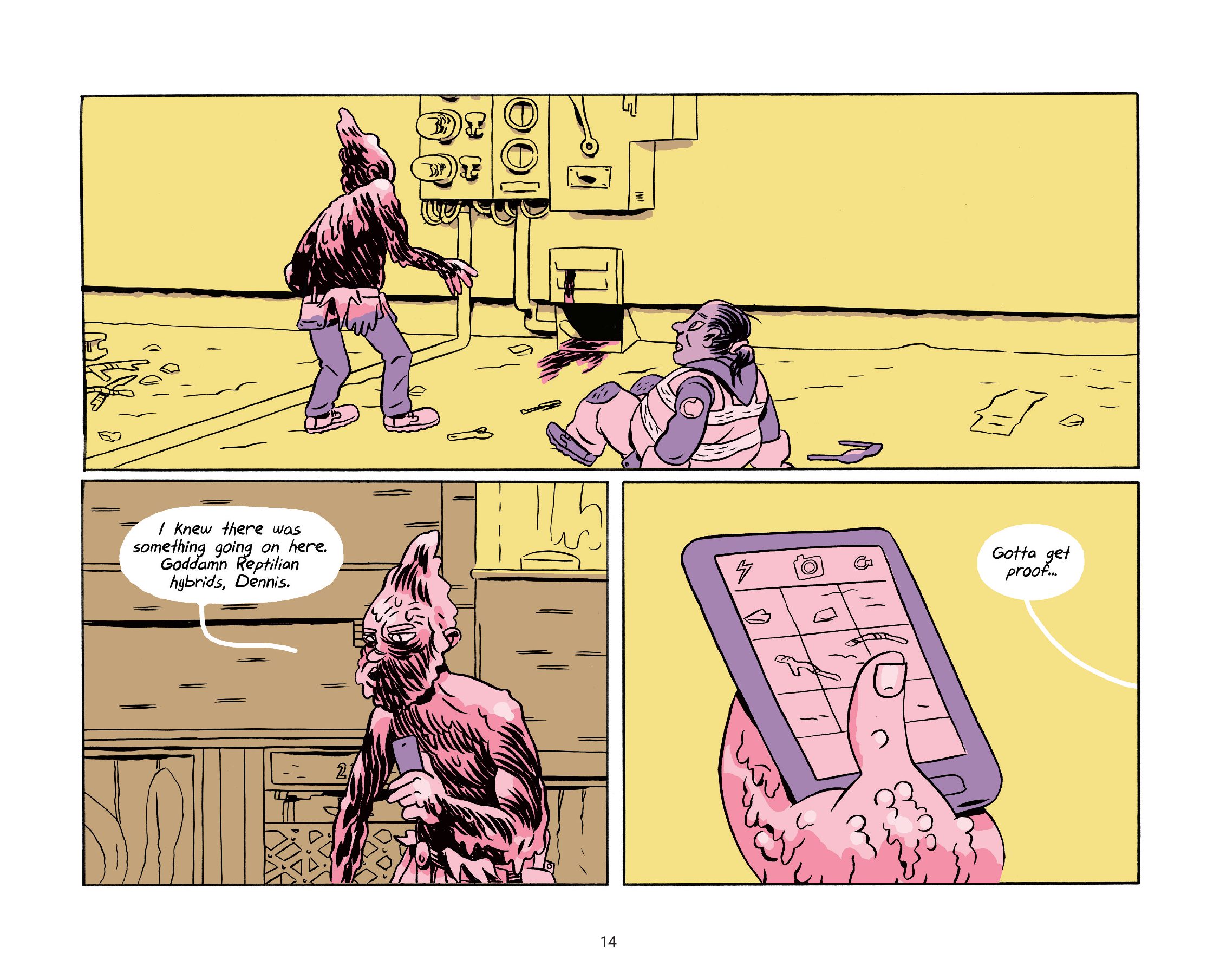Ezra Claytan Daniels is a writer and illustrator best known for his collaborative multimedia projects, which include video games, animations, feature documentaries, and graphic novels. In 2012 his graphic novel Upgrade Soul was released as a serialized interactive app on iOS and exhibited at venues including The Hyde Park Art Center, The Wexner Center for the Arts, and Chicago’s Museum of Contemporary Art before being re-published as a single volume graphic novel in 2018. Daniels is now back with BTTM FDRS, written in collaboration with the award-winning illustrator Ben Passmore (DAYGLOAYHOLE, Your Black Friend). Set in Chicago’s south side, BTTM FDRS deploys humor, horror, satire, and science-fiction to address the stakes involved in gentrification and cultural appropriation. Daniels is the winner of the 2017 McDuffie Award for Diversity in Comics.
***
The Rumpus: I’d like to begin by asking you about your background. Where did you grow up? When did you first get into comics?
Ezra Claytan Daniels: I grew up in Sioux City, which is a mid-sized town in Iowa, and I think I first got into comics when I discovered my Uncle Bobby’s collection of 70s era Marvel comics in the basement of my grandparent’s house. I don’t remember reading them as much as being really into the artwork, and trying to learn how to draw like that. Later, when I was in high school, I started drawing a comic strip for the school newspaper. It was like a weird superhero kind of thing that I hope never resurfaces. After that I kind of lost interest for a while, because in Sioux City there wasn’t access to any kind of underground or indie comics. It was just superhero stuff, and by the time I was eighteen or nineteen I had outgrown it a bit.
Rumpus: What reignited your interest?
Daniels: I moved to Portland, Oregon for art school where I discovered Sin City, Optic Nerve, Eightball, and Black Hole. These comics were like nothing I’d ever seen. I started making my own little self-published zines—again, just really painful auto-bio stuff that a twenty-year-old Portland dude would do—but through doing those comics I found my way into the local comics scene, and that just became my thing. From there comics were part of my creative expression, although I’ve always had day jobs, too.
Rumpus: I read that you have a professional background in trial graphics.
Daniels: That’s true. I was studying filmmaking in art school, but I dropped out after a couple of semesters because it was too expensive. And then I responded to this random job posting—I think it was on Craigslist or something—where they were looking for someone who could do medical and technical illustrations. Back in high school I had a job at a graphic design studio, so I already knew how to do commercial illustration. I got the job and ended up doing work for high stakes court cases.
Rumpus: Such as?
Daniels: Like if a doctor was being sued for malpractice, I would make an illustration to show specifically how the doctor messed up on the surgery. One of our clients was the Portland City Attorney’s Office, so any time a cop would kill somebody or something, I would be the guy they would send to the crime scene to create the topographical map where people could post magnets to show where they were when the event took place. I ended up doing that job off and on for different companies for almost ten years.
Rumpus: Did that experience directly inform your approach to visual storytelling?
Daniels: Absolutely. The goal was clarity; distilling complicated information into a graphic that can be read and discerned by a layman juror or judge from across the room in like five seconds. My drawing style for comics was very much informed by that. The other way was an appreciation for facts. Even though I don’t have a medical or scientific background, it was important to be accurate so I worked with experts in those fields. I still strive to have that kind of fidelity in everything I do. For example, when I wrote Upgrade Soul, I worked with an optical engineer and a geneticist as consultants on that project.
Rumpus: I can’t wait to talk with you about Upgrade Soul, but first I’d like to ask about earlier projects that brought you back into comics.
Daniels: The zines I did when I first got to Portland were like my comic school. The Changers, which came out in 2003, was my first proper comic, sort of like the freshman year of my comics life. At the time, the trial graphics company I’d been working for left Portland, and I was left with their client list of the top law firms in Oregon. I was charging like ninety dollars an hour, in the early 2000s, which was an insane amount of money for someone in his early twenties. I was only working maybe two or three days a month, but still able to build up enough money to spend most of my time working on this two-hundred-page science fiction epic graphic novel.
Rumpus: Was it self-published?
Daniels: I worked with this really great publisher called Pinball, which does really amazing art books, and I think just by having enough time and money to figure out how to do it, I was able to get it out through Diamond comic distributors and then go on a cross-country tour to promote it. I was cold emailing news outlets, and really hustling to make sure that book got out there.
Rumpus: How did that experience lead you to Upgrade Soul?
Daniels: I actually started writing Upgrade Soul even before working on The Changers. It’s about an elderly couple who are loosely based on members of my family. They go through an experimental rejuvenation procedure. Little do they know, the procedure uses cloning technology, and they are inadvertently cloned. Their clones are severely disfigured, but intellectually and physically they are vastly superior. They’re way more intelligent. They live twice as long. But they won’t be able to go through life with the same ease as their original counterparts. The whole story is about the nature of identity: how much of our identity is embedded in the way we look and the ease with which we’re able to move through the world—and how much of that is in our memories and our personalities. And, also, how much of our identities are informed by the limitations imposed on us by our society because of the way we look. I knew the story was too complex for my writing capabilities in my early twenties. So, I kind of set it aside, wrote The Changers, lived a bunch of life, and then started working on it again more intensely.
Rumpus: Upgrade Soul was originally released as a digital app in collaboration with the media artist Erik Loyer. Was that always the plan—to go digital as opposed to the traditional print format?
Daniels: I first developed the story as a standard comic. I was pitching it around to publishers every couple of years, and then I reached a stopping point. I just wasn’t getting any traction. And then a friend of mine, who I’d collaborated with on some projects in the past, Erik Loyer, was developing a platform for reading comics interactively on mobile devices. He hit me up to see if I had a project for it. I had already written the whole thing and illustrated some of the chapters. So, Erik and I developed an interactive comics language, and the first chapters were released on the app in 2012.
Rumpus: The transitions are really cool in the digital format, and there’s also a soundtrack that flows as the reader moves through the story.
Daniels: Yes, one of the things Erik is really into is harnessing music to amplify storytelling, so we hired an experimental composer and hip-hop producer called Alexis Gideon, who’s based in Pittsburgh. How it works is every time you swipe a page, it changes the musical accompaniment. The music keeps perfect pace with your progress through the book. Also, when you interact in other ways, such as tapping the screen, it makes a note that’s in harmony with the music in the background.
Rumpus: That’s very innovative! What was it was like then to later translate Upgrade Soul into a more traditional book?
Daniels: Even though it was introduced to the world as an interactive app, because I originally imagined it as a book, I started writing it in a standard comic-book-size format, and continued to do that as I developed it as an app. The only difference was I had to draw each panel in layers for the app because it has a parallax depth effect so when you move the device it looks like you’re looking into a 3D picture box. When I prepared the book for press, all I had to do was flatten the Photoshop files. The transition was super seamless.
Rumpus: Tell me about how you developed your new book: BTTM FDRS.
Daniels: I started working on this project in 2005 or 2006, really like a love letter/reportage almost of my first couple of years living in Chicago. I moved there with my best friend, Shelley Short, who’s a singer-songwriter from Portland soon after I was done touring for The Changers. We immediately became immersed in the underground music scene, and we lived in this art squat house with a bunch of people who were in bands. They were practicing all the time, and we had house shows all the time. Almost every weekend, we’d wake up and there would be random people sleeping on the floor. That was our life for the first couple of years. Many details in BTTM FDRS are an homage to that time and place—and people who lived in that house will get that. At first it was more focused on horror/sci-fi, but around 2015, I returned to writing it, and that’s when I started to bring in all of the layers involving gentrification, which I felt more acutely than when I first moved to Chicago.
Rumpus: When in this process did you begin collaborating with Ben Passmore?
Daniels: I was working on a rewrite in 2013 when I went to CAKE (Chicago Alternative Comics Expo)—this is kind of my hometown show and I try to go every year. I was tabling when this dude came walking down the aisle giving people copies of his self-published comic called DAYGLOAYHOLE. He caught my eye because he looks exactly like me! He came up to my table and showed me his book. As soon as I saw it, I was floored by how good it was. I had never heard of him before, but I was like this is a guy whose name should be on everyone’s tongue. I knew I had to work with him on something! We became fast friends, and then I was asked to contribute a short story to a sci-fi romance anthology called Speculative Relationships. I thought it would be a good opportunity to try out a collaboration with Ben. It went super smoothly, so I reached out to see if he wanted to draw BTTM FDRS.
Rumpus: The book is a horror satire set in a fictional neighborhood called Bottomyards. Could it have just as easily been set in real neighborhood, in other cities, for example Baltimore or Oakland, where gentrification has produced similar effects?
Daniels: Absolutely, all over the world.
Rumpus: The main character, Darla, is a black woman. Tell me more about your decision to tell this story from a female perspective, and not, say, from your perspective?
Daniels: The only reason I cast the main character as a black female is because I wanted to see more black female characters represented in fiction. That was the initial impulse, but she’s also inspired by my Aunt Darla, who’s black, and the most badass survivor in my life, and also by my girlfriend, Buki. I met Buki after I wrote the first draft but she ended up being a really big influence on that character. Like Darla, she went to the Art Institute of Chicago, and was one of the only black women in her graduating class, and she was trying to eke out a living as an artist and just being aware of how she was being tokenized in certain circles. The character of Darla is drawing tangentially from a lot of life experience, even though obviously my life is not one of a black woman.
Rumpus: In the book Darla is an aspiring fashion designer who’s come to Bottomyards in search of cheap rent—but others come with very different stakes.
Daniels: One way to think of this is that the story is metaphorically about appropriation in music. The beef between the two main characters is inspired by the beef between Nicki Minaj and Iggy Azalea. The idea is there is this black woman who’s trying to get back in touch with this cultural tradition, and express this tradition as she’s entitled to. And there’s her white friend who’s trying to usurp that by just maintaining proximity to that tradition. All of the characters in fact represent different facets of the hip-hop community. Gene, the landlord, is like a metaphor for the record exec who sees there’s money to be made in this thing but doesn’t quite understand it. He’s just trying to monetize it any way he can. Patrick, the utility worker, is a metaphor for the music nerd, like a record store worker who’s super into this thing. He’s deep into the details but constantly gets things wrong. He’s just obsessed with unearthing the secrets behind it, so he gets obsessed with a conspiracy theory about the building. And the building itself is a metaphor for the packaging of culture. The monster in the building is a metaphor for hip-hop specifically. Everyone wants to get hold of this thing that was created as this benevolent entity designed to help people but it gets weaponized by different people who want to exploit it in different ways but don’t understand it.
Rumpus: The story also directly addresses the racial bias of media, which reframes Darla’s story from the perspective of her white best friend.
Daniels: Yes, when the story is spun by the media it completely distorts the reality.
Rumpus: I’m thinking about what you said earlier about how certain perspectives are privileged while others are disregarded or co-opted. As in the story, black lives and perspectives have historically been underrepresented in the broader world of comics, particularly in the big commercial franchises. Do you see that beginning to shift?
Daniels: I do feel that diversity in representation is getting better, but I think it’s important to be clear that this isn’t necessarily coming from a place of increased media ethics. I think it’s coming from a place of seeing dollar signs. I think a lot of the interest in the industry is coming from Get Out. It’s mind-boggling, but it’s the first time when gatekeepers realized there’s money to be made on black stories even though black stories have been making money hand over fist for decades. Get Out was like the first time people actually admitted it. For years people would say, “We can’t do a Black Panther movie because there’s no audience for it.” Or, “Black people don’t come to theaters.” Or, “We can’t do a diverse cast because people don’t respond well to diverse casts.” Meanwhile, I point to The Fast and the Furious franchise. Next to the Marvel franchise, it’s probably the most successful franchise in history with a diverse cast of all different races and well represented characters. Instead of taking the lesson that movies like this can sell, they took only that people like car chases. But when Get Out came out, people couldn’t point to another aspect of that story—race was so embedded that they had to realize that was the sell.
Rumpus: But is the risk that diverse narratives will then be appropriated by others?
Daniels: There’s a huge wave of black horror coming out in the wake of Get Out—including one called Ma. From the trailer it looks like Jordan Peele’s work, but when I looked it up it’s directed by the guy who did The Help. This is definitely not what Jordan Peele intended to do with Get Out. To be fair, I haven’t seen Ma. It could be good… looking back at the history of Afrofuturist film, a lot of people would consider The Brother from Another Planet one of the foundational works. That was a movie written and directed by a white man, but he got enough right that it’s earned its place in the canon. I see that happening in comics, too. It’s something that I’m self-conscious about with BTTM FDRS because the industry has changed so much from when I first started working on it. There are other comics coming out with black female leads, but they’re not created by black female authors. I’m conflicted about it because obviously these stories should be told by black women, but at the same time a lot of the people who are in the position to tell these stories aren’t black women—at least not yet.
Rumpus: If appropriation is inevitable, is there a more ethical approach to telling stories?
Daniels: In BTTM FDRS, in an ideal world Darla’s white best friend would have taken a step back when the media came around and she would have said, “This is not my story.” The thing I tell my white friends who are dabbling with creating stories from other perspectives, and want to get things right, is to provide a platform for marginalized voices to tell their own stories.
***
Images provided courtesy of Fantagraphics/Ezra Claytan Daniels.








